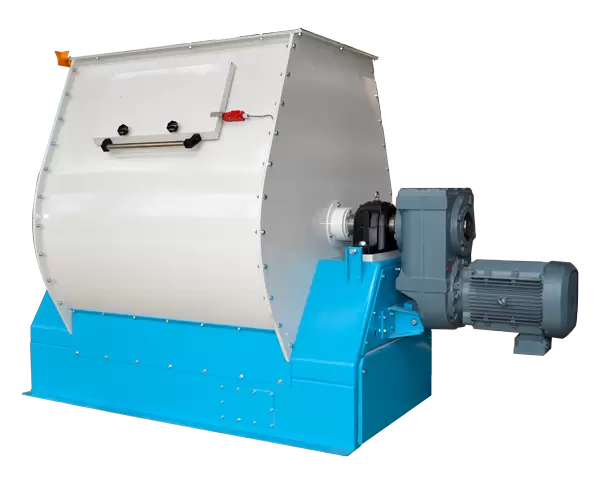In the production practice of modern agriculture and animal husbandry, feed mixers play a vital role as key equipment to improve production efficiency and ensure feed quality. Choosing a suitable feed mixer can not only improve the mixing uniformity of feed, but also effectively reduce production costs and enhance the digestion and absorption efficiency of feed by animals. However, facing the dazzling array of feed mixer products on the market, how to scientifically select has become a major challenge faced by many breeders and feed production companies. This article aims to provide a systematic purchase guide to help users comprehensively consider from multiple dimensions to select the feed mixer that best suits their needs.
Demand analysis: It is necessary to clarify your own mixing requirements. This includes the type of feed (such as complete feed, concentrate, premix, etc.), production scale (daily output or batch processing volume), and the desired mixing uniformity standard. Different types and scales of feed production have different performance requirements for mixers. For example, complete feed production usually requires efficient and large-capacity mixers to meet the needs of continuous production; while premixes focus more on high-precision and small-batch uniform mixing.
Capacity selection: Determine the effective volume of the mixer according to the production scale. If the volume is too small, it cannot meet the production needs and affect the efficiency; if the volume is too large, it may cause waste of resources and increase costs. Generally speaking, the actual feeding amount of the mixer should be 60%-80% of its rated capacity to ensure the best mixing effect and equipment life.
The common feed mixers on the market mainly include vertical mixers, horizontal mixers, twin-shaft mixers and single-shaft mixers. Each type has its own advantages and disadvantages, and the applicable scenarios are also different.
Vertical feed mixer: suitable for small farms or feed processing points, with a small footprint and low cost, but a long mixing cycle, suitable for small batch production.
Horizontal feed mixer: divided into single-shaft and twin-shaft types. The single-shaft mixer has a simple structure and is suitable for small and medium-sized farms; the twin-shaft mixer has high mixing efficiency and is suitable for large farms or feed factories, especially for high-density materials. The mixing effect is better.
Twin-shaft feed mixer: mostly used in large production lines, can quickly and evenly mix large amounts of feed, but the investment cost is relatively high.
Single-shaft feed mixer: suitable for small and medium-sized enterprises, cost-effective and easy to maintain.

Mixing uniformity: It is the primary indicator for evaluating the quality of feed mixers. A high-quality mixer should be able to achieve a highly uniform mixture of the various components of the feed in a relatively short period of time, and the coefficient of variation CV value is generally required to be less than 10%.
Power and energy consumption: Select the appropriate motor power according to the capacity and working intensity of the mixer, and consider the energy efficiency ratio at the same time, and choose energy-saving and environmentally friendly products.
Material and durability: The material of the mixing drum and paddles directly affects the wear resistance and service life of the equipment. Stainless steel, carbon steel galvanized and other materials are more common, among which stainless steel has strong corrosion resistance and is more suitable for mixing feed with high humidity.
Safety design: Ensure that the mixer has the necessary safety protection measures, such as overload protection, emergency stop button, etc., to avoid accidents during operation.
Convenience of operation: The humanized operation interface and simple maintenance methods are also factors that cannot be ignored when choosing. The easy-to-clean mixing chamber and the quick-change accessories design can greatly improve the efficiency of daily use.
Choose a brand with a good market reputation and after-sales service system. High-quality after-sales service can respond quickly when equipment fails, reduce downtime, and ensure production continuity. At the same time, big brands often mean more mature technology and more reliable product quality.
On the basis of meeting all the above conditions, a cost-effectiveness analysis is required in the end. In addition to the initial purchase cost, the operating cost (energy consumption, maintenance costs), depreciation costs, and potential production stoppage losses should also be considered. Sometimes, high-efficiency and energy-saving models with slightly higher investment may have a higher cost-effectiveness in the long run due to their lower use costs.
In summary, choosing a suitable feed mixer is a comprehensive decision-making process involving many factors. Starting from clarifying your own needs, combined with multiple considerations such as equipment type, performance parameters, safety, brand reputation and cost-effectiveness, you can make a wise choice. In actual operation, it is recommended to conduct multiple inspections and comparisons, and even consult professionals or refer to the experience of peers to ensure that the selected equipment is in line with production reality to the greatest extent and create the greatest value for the enterprise.
As a feed mixer company, we are committed to providing high-quality and high-efficiency mixer equipment to meet the needs of agricultural and animal husbandry production. We not only focus on product performance and reliability, but also pay attention to user experience and environmental friendliness, adopt energy-saving design, and reduce energy consumption and carbon emissions.